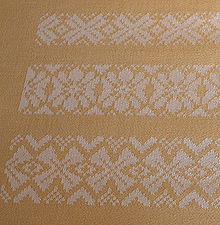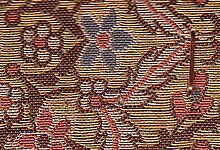damask
Damask (from Italian ; after Arabic دمشق Dimashq , name of the city Damascus ) is a fabric , in which the warp and schusssichtige parts alternate, making it possible to weave figurative patterns of all kinds. The patterns can be distributed arbitrarily across the width of the weave. Damasks are usually made on special looms with pulling devices.
Due to the complex weaving technique and the high tensile load on the warp threads, damasks are only made with very high quality and smooth, shiny materials, earlier silk , fine worsted and linen , from the 20th century mainly made of mercerized cotton . The fabric can be of the same color in the warp and weft, then the woven-in pattern is only clearly visible under angled incidence of light; however, the pattern can also be accentuated with a different colored weft. Popular uses are plain colored tablecloths and bed linen .
Web technology in general
To weave real damask you only need one warp system, but two shaft or lifting systems: the basic shaft and the sample shaft . The plain weave on the Grundschäften or the front dishes to no perceptible ridge have. Therefore, the following are used:
- Cross twill
- five-volume atlas
- six-volume atlas
- eight-volume atlas
The pattern is carried out on the basis of the stitches , i.e. groups of threads that are arranged in a strand on the sample shafts . The number of warp threads in a stitch depends on the basic weave used: with cross twill four threads form one stitch, with five-string atlas five warp threads, with six-string atlas six warp threads and with eight-string atlas eight warp threads. The strands of the sample harness hang only at the top in a shaft strip and are individually weighted at the bottom with weights (plumb bobs), which ensure automatic lowering.
When lifting the stitches a cross arises trade . In order for this to develop before the basic shafts, so that a shuttle can be shot through, the strands on the basic shafts must have extremely long eyes up to 8 cm in length. Nevertheless, the compartment is considerably smaller than usual, which is why special, very low damask boats are used. The sample stocks must be a reasonable distance from the base stocks. The loom must be extended for this.
The weaving technique requires that the representation of figurative motifs takes place in square pixels , that is, the outline of the pattern is stepped. This is because a full repeat of the basic weave has to be woven for each dug stitch . The greater the number of warp threads in a stitch, the coarser and more layered the pattern will be. This is why half stitches of three or four warp threads are also possible with 6-thread and 8-thread atlas.
Zampelsystem
The pull cords of each sample shaft lead upwards, are arranged in a perforated board and passed over the loom structure to the front in front of the comb drawer. Each pull cord ends in a handle, the Zampel . The Zampel are arranged a little above the weaver's eye level according to the sequence of the sample shafts so that the weaver can selectively lift one or more sample shafts by pulling and hooking the Zampel.
The woven-in motifs are distributed equally over the entire width of the weave or mirrored against each other, depending on the drawing-in of the stitches on the sample shafts (straight through or in zigzag).
The number of Zampel or sample stocks limits the possibilities of sampling. For example, with 100 tampers, a single figure motif like a rose blossom can be a maximum of 100 stitches wide. With an 8-strand atlas and an assumed warp density of 40 threads per centimeter, five stitches per centimeter and 20 cm total width of the motif would be possible, with a 5-strand atlas eight stitches per centimeter, but only 12.5 cm total width of the individual motif.
Harness system
Each individual thread group (stitch) on the sample shafts has its own harness cord, which ends in a cord loop. It is therefore possible to dig out each individual stitch independently of one another over the width of the fabric and, for example, to weave in writing or similar non-repeating motifs. In contrast to the Zampelsystem, the order of the strands on the sample shafts is completely indifferent.
The greater flexibility of the system is offset by the effort required to pull out a single report. The harness cords can either be led forward to the weaver and to the side, where they can be pulled out by an assistant.
Other weaving techniques on the draw loom
With a jacquard attachment, each individual warp thread can be lifted independently of one another. The lifts are controlled by punch cards . The figurative motifs of a fabric named after the inventor jacquard therefore do not have graduated, but smooth contours, whereby jacquard fabrics can be easily distinguished from real damask.

Types of weave such as Samitum , Taqueté and Lampas, which work with two warp systems and thus enable fabrics with a four-color pattern, were also produced on draw-looms . Lampas is woven with a main chain in canvas , twill and satin weave and a binding chain for the patterning of images (figure shots), occurs in Italian, Spanish and French fabrics of the late Middle Ages and the Renaissance and is used today for heavy upholstery fabric or for paraments . In contrast to this, the main chain in Samitum has no binding function, the various wefts take place in both warp systems in the same way in plain and twill weave.
history
Damask was first produced in China . Its use spread through India , Persia and Syria on the Silk Road to Europe. During the 12th century, the fabric produced in Damascus became so popular that the fabric took over the city name.
In Großschönau in the Oberlausitz in 1666 was first woven in Germany damask. The German Damask and Terrycloth Museum Großschönau documents the history of the local damask weaving and shows a functioning damask loom.
Today in Europe only the Serbian silk manufacturer Novitet-Dunav in Bezdan weaves damask fabrics on looms from the 17th century.
literature
- Erika Arndt: Weaving manual. History, materials and techniques of hand weaving . Bern 2006, ISBN 3-258-06993-X .
- Lillemor Johansson: Damask and Opphämpta with weaving sword or drawloom . Stockholm 1984, ISBN 91-36-02158-X (English language).
- Maren Raetzer: Damask from Großschönau. The production facility and the works of art woven there from the 17th to the 19th centuries. (= Writings on cultural studies , vol. 52.) Kovač, Hamburg 2003, vol. 1. Text, 402 pp., Ill., Graph. Darst .; Vol. 2, catalog and illustrations, 268 p., 94 sheets, num. Ill .; ISBN 978-3-8300-0864-4 , dissertation at the University of Göttingen .
Movie
- Expensive cloths - yard goods from Upper Lusatia. Documentary, Germany, 2018, 29:42 Min, written and directed by Linda Sweet, Production. Central German Broadcasting , Row: The East - discover where you live , TV: April 3, 2018 at MDR television , Summary of MDR, online- Video available until July 14, 2019.
See also
Web links
Individual evidence
-
↑ Brigitte Tietzel: History of the art of weaving. Technical basics and artistic tradition. DuMont, Cologne 1988, ISBN 3-7701-1828-6 , pp. 253-254 and
Paul-August Koch & Günther Satlow: Large Textile Lexicon. Specialized lexicon for the entire textile industry L – Z. Deutsche Verlags-Anstalt Stuttgart 1966, p. 5, keyword: Lampas . - ↑ Maren Raetzer: Damascus from Großschönau. The production facility and the works of art woven there from the 17th to the 19th centuries. (= Writings on cultural studies , vol. 52.) Kovač, Hamburg 2003, 878 pp., ISBN 978-3-8300-0864-4 .



